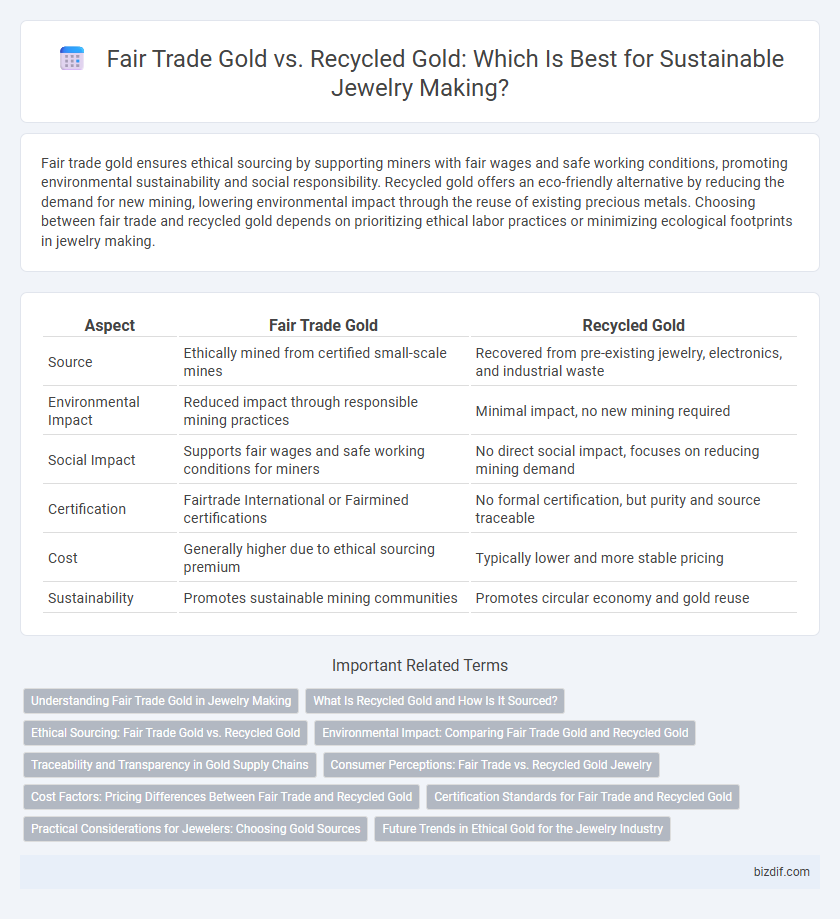Fair trade gold ensures ethical sourcing by supporting miners with fair wages and safe working conditions, promoting environmental sustainability and social responsibility. Recycled gold offers an eco-friendly alternative by reducing the demand for new mining, lowering environmental impact through the reuse of existing precious metals. Choosing between fair trade and recycled gold depends on prioritizing ethical labor practices or minimizing ecological footprints in jewelry making.
Table of Comparison
| Aspect | Fair Trade Gold | Recycled Gold |
|---|---|---|
| Source | Ethically mined from certified small-scale mines | Recovered from pre-existing jewelry, electronics, and industrial waste |
| Environmental Impact | Reduced impact through responsible mining practices | Minimal impact, no new mining required |
| Social Impact | Supports fair wages and safe working conditions for miners | No direct social impact, focuses on reducing mining demand |
| Certification | Fairtrade International or Fairmined certifications | No formal certification, but purity and source traceable |
| Cost | Generally higher due to ethical sourcing premium | Typically lower and more stable pricing |
| Sustainability | Promotes sustainable mining communities | Promotes circular economy and gold reuse |
Understanding Fair Trade Gold in Jewelry Making
Fair Trade Gold in jewelry making ensures that the gold is sourced ethically, supporting small-scale miners with fair wages and safe working conditions. Unlike recycled gold, which is repurposed from existing jewelry, Fair Trade Gold promotes social responsibility and environmental sustainability at the point of extraction. This ethical sourcing appeals to conscious consumers seeking transparency and positive impact in luxury items.
What Is Recycled Gold and How Is It Sourced?
Recycled gold is extracted from previously used jewelry, electronic components, or industrial materials, reducing the need for new mining and minimizing environmental impact. This gold undergoes a refining process to eliminate impurities and restore its purity, making it ideal for sustainable jewelry making. Sourcing recycled gold supports circular economy principles by reintroducing precious metals into the supply chain without the ecological and social costs associated with traditional mining.
Ethical Sourcing: Fair Trade Gold vs. Recycled Gold
Fair trade gold guarantees ethical sourcing by ensuring miners receive fair wages, work in safe conditions, and support sustainable environmental practices, directly benefiting impoverished communities. Recycled gold reduces the demand for new mining but lacks certification to verify labor conditions or community impact in its original extraction. Choosing fair trade gold prioritizes social responsibility and transparency, while recycled gold emphasizes environmental sustainability through material reuse.
Environmental Impact: Comparing Fair Trade Gold and Recycled Gold
Fair Trade gold ensures ethical sourcing with lower environmental degradation by supporting responsible mining practices that reduce deforestation and harmful chemical use. Recycled gold significantly minimizes environmental impact by reusing existing materials, thereby reducing the demand for new mining and conserving natural resources. Both methods contribute to sustainability, but recycled gold typically has a smaller carbon footprint due to the elimination of extraction processes.
Traceability and Transparency in Gold Supply Chains
Fair trade gold certification ensures traceability by requiring miners to meet strict social and environmental standards, enabling consumers to verify the ethical origin of the gold. Recycled gold, while promoting sustainability, often lacks comprehensive traceability records, as it can be sourced from various previous uses and supply chains with limited transparency. Transparency in gold supply chains is critical to combating illegal mining and environmental harm, making fair trade gold more reliable for consumers prioritizing ethically sourced jewelry materials.
Consumer Perceptions: Fair Trade vs. Recycled Gold Jewelry
Consumers often perceive fair trade gold jewelry as more ethically transparent due to its certification and support for mining communities, while recycled gold jewelry appeals for its environmental sustainability by reducing mining demand. Studies show a growing preference for recycled gold among eco-conscious buyers who prioritize reducing environmental impact over mining labor conditions. Both types attract distinct markets, with fair trade favored for social responsibility and recycled gold for circular economy values.
Cost Factors: Pricing Differences Between Fair Trade and Recycled Gold
Fair trade gold typically commands higher prices due to ethical mining practices, certification costs, and community development fees integrated into the supply chain. Recycled gold, sourced from pre-existing materials like old jewelry or industrial scraps, often costs less because it bypasses traditional mining expenses and environmental restoration fees. Pricing differences reflect the balance between sustainability commitments in fair trade gold and the environmental benefits paired with cost-efficiency of recycled gold in jewelry making.
Certification Standards for Fair Trade and Recycled Gold
Fair trade gold is certified through rigorous standards such as Fairtrade Gold and Fairmined certifications, which ensure ethical sourcing, environmental protection, and fair labor practices in artisanal mining communities. Recycled gold certification often aligns with standards like the Responsible Jewellery Council (RJC) Chain of Custody, guaranteeing traceability and sustainability by reusing existing gold without new mining impact. Both certification systems promote transparency and accountability but differ in their environmental and social focus, with fair trade gold emphasizing community benefits and recycled gold prioritizing resource conservation.
Practical Considerations for Jewelers: Choosing Gold Sources
Jewelers must evaluate the ethical impact and supply chain transparency when choosing between fair trade gold and recycled gold sources. Fair trade gold offers assured adherence to labor and environmental standards, while recycled gold reduces reliance on mining and minimizes environmental footprints. Cost, availability, and customer demand also influence the practical decision-making process in sourcing gold sustainably.
Future Trends in Ethical Gold for the Jewelry Industry
Fair trade gold ensures traceability and supports artisanal miners by guaranteeing fair wages and environmentally responsible practices, while recycled gold reduces the demand for new mining and minimizes environmental impact. The jewelry industry is increasingly shifting towards a hybrid approach that combines fair trade certifications with recycled sources to meet consumer demand for transparency and sustainability. Emerging technologies like blockchain are further enhancing supply chain verification, propelling ethical gold practices into the future of responsible jewelry making.
Fair trade gold vs recycled gold Infographic

 bizdif.com
bizdif.com